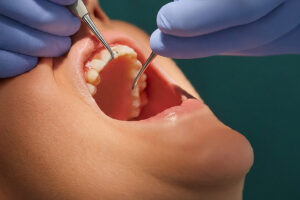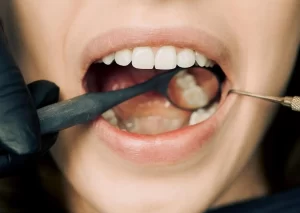Can you get dry socket with stitches? Yes, you Can

Dry sockets predominantly arise in the lower jaw, typically following the extraction of molars. The placement of stitches post-extraction, especially after removing an impacted tooth, does not safeguard against dry sockets. Individuals who smoke or women who use birth control pills face a higher risk of developing dry sockets.
Table of Contents
What is a dry socket?
A dry socket is a painful dental condition that occurs when the blood clot at the site of a tooth extraction fails to develop, dissolves, or dislodges prematurely, exposing the underlying bone and nerves.
This complication delays healing and can lead to significant pain and discomfort. Read more: Dry Socket: Causes, Symptoms & Treatment
Signs of dry socket with stitches
Signs of a dry socket, even when stitches are present, include:
- Severe pain: Intensifying pain within a few days after tooth extraction, not relieved by over-the-counter pain medication.
- Visible bone: The extraction site appears empty or you can see the bone, indicating the absence of a blood clot.
- Bad breath or unpleasant taste: Due to exposed tissue and possible infection.
- Radiating pain: Pain that spreads from the socket to your ear, eye, temple, or neck on the same side of your face as the extraction.
- Swollen lymph nodes: Around your jaw or neck, indicating your body is fighting an infection.
- Slight fever: A body’s response to infection, though not always present.
Follow up with your dentist if you experience these symptoms, as dry socket requires professional treatment.
Can Stitches Prevent Dry Socket?
Stitches themselves do not prevent dry socket.
Dry socket occurs when the blood clot that should form in the socket after a tooth extraction to promote healing is dislodged or dissolves.
While stitches are used to help the gum tissue heal and to keep it secure after an extraction, especially for surgical extractions or when a tooth is impacted, their primary role is not to prevent the clot from dislodging.
The risk of dry socket is more closely related to factors such as the extraction technique, the location of the extracted tooth (with lower teeth being more susceptible), smoking, poor oral hygiene, and the use of birth control pills, rather than the presence or absence of stitches.
Proper post-operative helps preventing dry socket, including following the dentist’s instructions on not smoking, avoiding sucking actions, and gentle rinsing.
How to treat dry socket with stitches
Treating dry socket in the presence of stitches requires careful management to alleviate pain and promote healing while not disturbing the stitches or the extraction site.
Here’s a general approach:
- Professional care: The first step is to see your dentist or oral surgeon. They can confirm the diagnosis of dry socket and provide appropriate treatment.
- Cleaning the socket: Your dentist might gently clean the socket to remove any debris that could be contributing to the infection or irritation.
- Medicated dressings: A medicated dressing or gel is often placed in the socket to reduce pain and protect the area. This dressing may need to be replaced every few days in the initial stages of treatment.
- Pain management: Over-the-counter pain relievers or prescription medications can help manage the pain. Your dentist may recommend the best options for you.
- Antibiotics: If there is evidence of infection, antibiotics may be prescribed to prevent further complications.
Home Care Instructions
You’ll be advised on how to care for the dry socket at home, which may include:
- Avoid smoking and using straws, as the sucking motion can dislodge the blood clot in the healing socket.
- Gently rinse with salt water or a prescribed antimicrobial mouthwash to promote healing and reduce the risk of further infection.
- Continue with good oral hygiene practices, being careful around the extraction site.
- Don’t use your CPAP machine until healed. Read more: Will CPAP Cause Dry Socket?
Regular follow-up visits may be necessary to monitor the healing process and replace the medicated dressing until the socket begins to heal properly.
Can you get dry socket with bone graft and stitches
Yes, it is possible to get dry socket even if you have had a bone graft and stitches following a dental procedure, such as tooth extraction.
Dry socket happens when the blood clot that forms in the socket (the hole in the bone where the tooth has been removed) is dislodged or dissolves before the wound has had a chance to heal.
This leaves the underlying bone and nerves exposed to air, food, fluid, and bacteria, leading to pain and a risk of infection.
When a bone graft is placed in the socket after tooth extraction, it is typically covered with a collagen membrane and then sutured to promote healing and to support the regeneration of bone.
If the blood clot that forms over the graft material becomes dislodged or fails to form properly, it can lead to a similar condition as dry socket.
The risk might be somewhat mitigated by the presence of the graft material and stitches, as they can provide some protection to the underlying bone and nerves, but the risk is not entirely eliminated.
Can you get dry socket with stitches wisdom teeth
Yes, you can still get dry socket after wisdom teeth removal even if you have stitches. Stitches help close the gum tissue but don’t prevent the clot from being dislodged. Follow your dentist’s care instructions to reduce the risk.
How to prevent dry socket
To prevent dry socket after a tooth extraction, follow these guidelines:
- Follow oral hygiene instructions: Carefully follow your dentist’s instructions on oral hygiene to keep the extraction site clean without disturbing the clot.
- Avoid smoking and tobacco: Smoking can inhibit healing and increase the risk of dry socket. Avoid smoking and using tobacco products for at least 48 hours after your extraction.
- Avoid sucking motions: Avoid using straws, spitting, or any actions that create a sucking motion, as these can dislodge the blood clot.
- Soft diet: Eat soft foods that don’t require much chewing and avoid hard, crunchy, or sticky foods that might disturb the clot.
- Avoid alcohol: Alcohol can interfere with the healing process. Avoid alcoholic beverages, especially in the first 24 hours after surgery.
- Gentle mouth rinses: If advised by your dentist, gently rinse your mouth with warm salt water or a prescribed mouthwash to keep it clean without dislodging the clot.
- Limit physical activity: Reduce physical activity for a few days after the extraction to minimize the risk of dislodging the blood clot.
FAQ on Can You Get Dry Socket with Stitches
How common is dry socket with stitches?
Dry socket occurs in about 2% to 5% of tooth extractions and is less common when stitches are used, as they help protect the extraction site. However, stitches do not completely eliminate the risk, especially if post-operative care instructions are not followed carefully. The risk can be higher with wisdom tooth extractions, where the incidence of dry socket can be higher, ranging from 20% to 30% in cases without preventive measures.
When can I stop worrying about dry socket with stitches?
You can generally stop worrying about dry socket 7 to 10 days after your tooth extraction, as the risk significantly decreases once the initial healing phase has passed. This timeline is the same whether you have stitches or not, as stitches primarily help the gum tissue heal and do not directly impact the formation or protection of the blood clot in the socket.
How long after surgery are you at risk for dry socket?
You are at risk for dry socket typically within the first 3 to 5 days after surgery. This is when the blood clot that forms in the extraction site is most vulnerable to being dislodged. After about a week, the risk significantly decreases as the healing process advances and new tissue starts to form over the extraction site.
What are the warning signs of dry socket?
The warning signs of dry socket include:
– Severe pain: Intense pain at the extraction site or radiating to the ear, eye, temple, or neck on the same side, typically starting 1-3 days after the extraction.
– Visible bone: Loss of the blood clot at the extraction site, leading to visible bone within the socket.
– Bad breath or unpleasant taste: Due to exposed bone and possible infection.
– Lack of healing: The extraction site appears to not be healing as expected.
– Swollen lymph nodes: Around the neck or jaw, indicating a possible infection.
– Fever: A sign of infection that could be related to dry socket or other complications.
If you experience any of these symptoms after a tooth extraction, contact your dentist or oral surgeon for evaluation and treatment.
What is the number 1 cause of dry socket?
The number 1 cause of dry socket is the dislodgement or dissolution of the blood clot at the extraction site. This clot plays a vital role in healing, acting as a protective layer over the underlying bone and nerves. Actions such as smoking, sucking through a straw, vigorous rinsing, or spitting can increase the risk of dislodging this clot, leading to dry socket.
What is the fastest way to get rid of a dry socket?
The fastest way to get rid of a dry socket is to seek treatment from a dentist or oral surgeon. Treatment typically includes cleaning the socket, removing debris, and applying a medicated dressing to alleviate pain and protect the area. Pain relief medication and antibiotics may also be prescribed if an infection is present. Regular follow-up appointments may be necessary to change the dressing until the socket begins to heal properly.
Will it be obvious if I have a dry socket?
Yes, it will likely be obvious if you have a dry socket due to distinct symptoms such as severe pain at the extraction site that can radiate to your ear, jaw, or neck, bad breath, an unpleasant taste in your mouth, and visible bone in the socket. These symptoms typically emerge 1-3 days after the tooth extraction and are significantly more intense than normal post-operative discomfort.
How to tell the difference between dry socket and normal pain?
Dry socket differs from normal post-operative pain in several key ways. Normal pain peaks within the first two days and gradually subsides, while dry socket pain intensifies and often radiates to the ear, jaw, or neck, starting 2-3 days post-extraction. Dry socket is marked by severe discomfort, the absence of the protective blood clot, leading to visible bone in the socket, and is accompanied by bad breath or an unpleasant taste, symptoms not typical of normal healing.
Should I still have pain 5 days after tooth extraction?
It’s not uncommon to still experience some pain 5 days after a tooth extraction, as the healing process is still ongoing. The pain intensity should decrease by this time. If the pain remains severe, worsens, or is accompanied by symptoms like fever, bad breath, an unpleasant taste, or visible bone in the socket, it could indicate complications such as dry socket or infection.
Will a dry socket heal on its own?
A dry socket requires treatment from a dental professional to properly heal. While the body can eventually heal the socket on its own, treatment significantly reduces pain, accelerates healing, and prevents potential infections. Without treatment, the healing process can be very slow and painful. A dentist or oral surgeon typically cleans the socket, applies a medicated dressing to protect it, and may prescribe pain relief and antibiotics. This intervention helps ensure proper healing and alleviates the intense discomfort associated with dry socket.
Fact Checked
Our dedicated team rigorously evaluates every article and guide to ensure the information is factual, up-to-date, and free of bias.
Updated Regularly
We update our articles and reviews regularly to ensure you have access to the latest data in the dental industry.
The content on Dental3DU’s blog is intended for educational purposes only. This information should not be relied upon as professional medical counsel. Be sure to always consult with your dentist about the dangers and benefits of any medication, treatment or procedure.







